Description
Instruction for medical use of ROSUSTAR medicine Trade name Rosustar International unlicensed name Rosuvastatin Dosage Form of the Tablet, film coated. Structure One tablet contains active agent – rosuvastatin (in the form of calcium rosuvastatin) 5 mg, 10 mg, 20 mg excipients: lactoses monohydrate, cellulose microcrystalline type 102, calcium hydrophosphate anhydrous, krospovidon, magnesium stearate structure of a cover: opadr II pink 85F240091 (the polyvinyl alcohol which is partially hydrolyzed the titan dioxide (E171), a polyethyleneglycol/macrogoal, talc, gland (III) oxide red (E172)). The description of the Tablet of round shape, biconvex, film coated pink color, with an engraving of RS 5 on one party and smooth with another (for a dosage of 5 mg) Tablets of round shape, biconvex, film coated pink color, with an engraving of RS 10 on one party and smooth with another (for a dosage of 10 mg) Tablets of round shape, biconvex, film coated pink color, with an engraving of RS 20 on one party and smooth with another (for a dosage of 20 mg) Pharmacotherapeutic group Hypolipidemic drugs. Gipokholisterinemichesky and gipotriglitsirindemichesky drugs. Reductase HMG SoA ingibator. Rosuvastatin. The ATX C10AA07 code the Pharmacological Pharmacokinetics Absorption Maximum Concentration properties (Cmax) of rosuvastatin in blood plasma is reached approximately in 5 hours after administration of drug. The absolute bioavailability is about 20%. System exposure of rosuvastatin increases in proportion to a dose. Pharmacokinetic parameters do not change at daily reception. Distribution Gets through a placental barrier. Rosuvastatin is absorbed mainly by a liver which is the main place of synthesis of XC and metabolism of HS-LPNP. Distribution volume – 134 l. Linking with proteins of plasma (mainly with albumine) makes about 90%. Metabolism of Biotransformiruyetsya in a liver in small degree (about 10%), being non-core substrate for isoenzymes of a system of P450 cytochrome. As well as in case of other inhibitors of GMG-KoA-reduktazy, the specific membrane carrier – the polypeptide transporting (OATP) 1B1 organic anion which is carrying out an important role in its hepatic elimination is involved in process of hepatic capture of drug. The main isoenzyme participating in rosuvastatin metabolism is CYP2C9. Isoenzymes of CYP2C19, CYP3A4 and CYP2D6 are involved in metabolism to a lesser extent. The main metabolites of rosuvastatin are N-desmetil and lactonic metabolites. N-desmetil for about 50% is less active, than rosuvastatin, lactonic metabolites pharmacological are inactive. More than 90% of pharmacological activity on inhibition of the circulating GMG-KoA-reduktazy are provided with rosuvastatin, the rest – its metabolites. Removal About 90% of a dose of rosuvastatin is removed in not changed look through intestines, the rest – kidneys. Elimination half-life (T1/2) – about 19 hours, does not change at increase in a dose of drug. The average value of plasma clearance is about 50 l/h (coefficient of variation of 21.7%). Patients with a slight and moderate renal failure have a plasma concentration of rosuvastatin or N-desmetila significantly does not change. At patients with the profound renal failure (the clearance of creatinine (CC) less than 30 ml/min.) concentration of rosuvastatin in blood plasma is 3 times higher, and N-desmetila – by 9 times, than at healthy volunteers. Concentration of rosuvastatin in blood plasma at the patients who are on a hemodialysis is about 50% higher, than at healthy volunteers. At patients with point 7 and below on a scale of Chayld-Pyyu the increase in T1/2 of rosuvastatin is not revealed, at patients with points 8 and 9 on a scale of Chayld-Pyyu the lengthening of T1/2 is noted twice. Experience of use of drug for patients with more profound abnormal liver functions is absent. Gender and age have no clinically significant impact on rosuvastatin pharmacokinetics. Ethnic groups Pharmacokinetic parameters of rosuvastatin depend on race: the area under a curve concentration time (AUC) at representatives of Mongoloid race (Japanese, Chinese, Filipinos, Vietnamese and Koreans) is twice higher, than at representatives of Caucasian race. At Indians the average AUC and Cmax value is increased by 1.3 times. A pharmacodynamics Rosustar – hypolipidemic means from group of statines. Rosuvastatin is a selection competitive inhibitor of GMG-KoA-reduktazy – the enzyme turning GMG-KoA in mevalonat, the predecessor of cholesterol (XC). Increases number of receptors of lipoproteins of the low density (LDL) by the surfaces of hepatocytes that leads to strengthening of capture and catabolism of LDL, inhibition of synthesis of lipoproteins of very low density (LPONP), reducing the general concentration of LDL and LPONP. Reduces concentration of HS-LPNP, cholesterol not lipoproteins of the high density (HS-neLPVP), HS-LPONP, the general XC, (TG), TG-LPONP triglycerides, apolipoprotein B (ApoV), reduces ratios of HS-LPNP/HS-LPVP, the general HS/HS-LPVP, HS-neLPVP/HS-LPVP, ApoV / A-1 apolipoprotein (ApoA-I), increases concentration of HS-LPVP and ApoA-I. Hypolipidemic action in direct ratio to the size of the appointed dose. The therapeutic effect appears within 1 week after the beginning of therapy, in 2 weeks reaches 90% from maximum, by 4th week reaches a maximum and after that remains to constants. It is effective at adult patients with a hypercholesterolemia with or without gipertriglitseridemiya (regardless of race, a floor or age), including at patients with diabetes and a family hypercholesterolemia. At 80% of patients with a hypercholesterolemia of II and and the II b type (classification by Fredrikson) with average initial concentration of HS-LPNP about 4.8 mmol/l against the background of administration of drug in a dose of 10 mg the concentration of HS-LPNP reaches values less than 3 mmol/l. At the patients with a homozygous family hypercholesterolemia taking the drug in a dose of 20 mg, average decrease in concentration of HS-LPNP is 22%. The additive effect is noted in a combination with fenofibraty (concerning decrease in concentration of TG and with niacin in lipidsnizhayushchy doses (not less than 1 g a day) (concerning decrease in concentration of HS-LPVP). Indications – primary hypercholesterolemia (type II a across Fredrikson), including a heterozygous hereditary hypercholesterolemia, or the mixed (combined) hypercholesterolemia (type II b across Fredrikson) – as addition to a diet and other non-drug actions (physical activity and decrease in body weight) at inefficiency of a dietotherapy and non-drug actions – a homozygous form of a hereditary hypercholesterolemia and at the insufficient efficiency of a dietotherapy and other types of treatment directed to decrease in level of lipids (for example, aferez LDL) or if such types of treatment are not suitable the patient – for delay of progressing of atherosclerosis as addition to a diet at patients to whom therapy for decrease in concentration of the general in XC and HS-LPNP – prevention of the main cardiovascular complications (stroke, a heart attack, arterial revascularization) at adult patients without clinical signs of the coronary heart disease (CHD) is shown, but with the increased risk of its development (the age is more senior than 50 years for men and 60 years for women, the increased concentration of S-reactive protein are more senior (≥ 2 mg/l) in the presence of at least one of accessory factors of risk, such as arterial hypertension, low concentration of HS-LPVP, smoking, the family anamnesis of the early beginning of an ischemic heart disease). The route of administration and doses take the Drug inside, without chewing and without crushing, swallow entirely, washing down with water, irrespective of meal at any time. Prior to therapy by drug Rosustar the patient has to begin to keep to a standard hypolipidemic diet and to continue to observe it during treatment. The dose of drug should be selected individually depending on indications and the therapeutic answer, in view of the current standard recommendations about target levels of lipids. Treatment of a hypercholesterolemia: the recommended initial dose makes 5 mg or 10 mg as for the patients who were not receiving earlier statines and for the patients receiving GMG-KoA-reduktazy inhibitors once a day. When choosing an initial dose it is necessary to consider the level of cholesterol and risk of cardiovascular diseases and also possible development of side effects. If necessary in 4 weeks the change of the mode of dosing can be carried out. To patients with a severe form of a hypercholesterolemia with high risk of complications of cardiovascular diseases (in particular, with a family hypercholesterolemia) at which the dose of 20 mg did not give adequate clinical effect and behind which further medical observation will be carried out, purpose of the maximum dose of 40 mg has to be carried out after the 4-week term of treatment. Taking into account increase in amount of side effects at administration of drug in a dose of 40 mg, in comparison with lower dosages, observation of the expert at increase in a dose of drug to 40 mg is recommended. Prevention of cardiovascular diseases: the recommended dose of rosuvastatin makes 20 mg a day. Use for children Use of rosuvastatin for children can be carried out only under observation of experts of health care. Children and teenagers aged from 10 years up to 17 years (boys with an indicator 2 and more on a scale of Tanner, the girl with menarche proceeding not less than 1 year): the initial dose of rosuvastatin for children and teenagers with a heterozygous hereditary hypercholesterolemia makes 5 mg once a day. Range of doses is 5-20 mg once a day. The dose is selected individually for each patient depending on response of the child to the carried-out therapy. Children and teenagers have to be transferred to the standard diet lowering cholesterol level. It is necessary to adhere to this diet before the end of treatment. Safety and efficiency of the doses of drug exceeding 20 mg a day were not studied in this group of patients. Children are aged younger than 10 years: experience of use of drug in this group of patients is limited to a small amount of patients (from 8 to 10 years) with a homozygous hereditary hypercholesterolemia. In this regard, rosuvastatin is not recommended for use for children aged up to 10 years. Use for elderly patients For patients is more senior than 70 years the recommended initial dose makes 5 mg. Change of the mode of dosing is not required from this group of patients. Use for patients with a renal failure For patients with easy and average degree of a renal failure of changes of a dose is not required. The recommended initial dose for patients with average degree of a renal failure makes 5 mg (clearance of creatinine & lt, 60 ml/min.). Use of drug in a dose of 40 mg at patients with average degree of a renal failure is contraindicated. Use of rosuvastatin is contraindicated to patients with heavy degree of a renal failure. Use for patients with a liver failure was not observed strengthenings of system impact of rosuvastatin on patients with Chayld-Pyyu values 7 or below. However strengthening of system influence of rosuvastatin was observed at persons with Chayld-Pyyu values 8 and 9. At these patients the assessment of renal function has to be carried out. Data on persons with Chayld-Pyyu values higher than 9 are not available. Rosuvastatin is contraindicated to patients with any diseases of a liver in an active phase. Race Strengthening of system influence of rosuvastatin was observed at persons of Mongoloid race. The recommended initial dose at such patients makes 5 mg. Dosing at patients with predisposition to development of a myopathy the Recommended initial dose makes 5 mg. Side effects the Used lower than the parameters of frequency of side effects are defined as follows: often (from ≥ 1/100 to & lt, 1/10), infrequently (from ≥ 1/1000 to & lt, 1/100), it is rare (from ≥ 1/10000 to & lt, 1/1000), is very rare (& lt, 1/10000), not specified frequency – parameters of frequency cannot be estimated on the available data. Often – a headache, dizziness, an asthenic syndrome – nausea, a constipation, an abdominal pain – diabetes of the II type – myalgia – the proteinuria (with a frequency more than 3% at the patients receiving a dose of 40 mg) decreasing in the course of therapy and which is not connected with developing of a disease of kidneys, infections of urinary tract Very seldom – peripheral neuropathy, decrease in memory – a hamaturia – an arthralgia Infrequently – vomiting – cough, dispnoe – a skin itching, a small tortoiseshell, rash – passing dose-dependent increase in activity of a serumal kreatinfosfokinaza (KFK), at increase more than by 5 times in comparison with the upper bound of norm the therapy has to be temporarily suspended Seldom – pancreatitis – hepatitis, jaundice – a myopathy (including miozita), a rhabdomyolysis – a Quincke’s disease – tranzitorny increase in activity of aspartate aminotransferase and alaninaminotranspherase of not specified frequency – diarrhea – Stephens-Johnson’s syndrome, peripheral hypostases As well as at use of other inhibitors of GMG-KoA-reduktazy, the frequency of emergence has dose-dependent character, side effects are usually significant slightly and pass independently. At use of drug, changes of the following laboratory indicators were noted: increase in concentration of glucose, bilirubin, activity of alkaline phosphatase, gamma glutamiltransferazy. At use of other statines it was reported about the following side effects: depression, insomnia, decrease in potency. At prolonged use of rosuvastatin it was reported about isolated cases of an interstitial disease of lungs. Contraindications – hypersensitivity to rosuvastatin or other components of drug – liver diseases in an active phase, including continuous rises in levels of transaminases in blood serum of not clear etiology and any increase in the serumal transaminases exceeding triple value of the upper bound of norm – a heavy renal failure (clearance of creatinine & lt, 30 ml/min.), – a myopathy – intake of cyclosporine – pregnancy and the period of a lactation. Drug is also contraindicated to the women of childbearing age who are not using reliable methods of contraception. The dose of 40 mg is contraindicated to patients with the contributing factors to development of a myopathy/rhabdomyolysis. Serve as such factors: – average degree of a renal failure (clearance of creatinine & lt, 60 ml/min.) – a hypothyroidism – muscular disorders in the anamnesis of the patient or the family anamnesis, – availability of the anamnesis of toxic action on muscles at intake of other inhibitor of GMG-KoA-reduktazy or the fibrat – alcohol addiction – situations at which increase in plasma concentration is possible, – Mongoloid race – combined use from fibrata. Medicinal interactions Simultaneous use of rosuvastatin and cyclosporine does not affect plasma concentration of cyclosporine, however the effect of rosuvastatin amplifies (its removal slows down, AUC by 7 times, Cmax increases – by 11 times). Erythromycin enhances motility of intestines that leads to decrease in effect of rosuvastatin (AUC decreases by 20%, and Cmax – for 30%). At the patients receiving antagonists of vitamin K (for example, warfarin), monitoring of the international normalized relation (INR) as the beginning of therapy by rosuvastatin or increase in a dose of drug can lead to increase in MNO is recommended, and cancellation of rosuvastatin or decrease in its dose can lead to its reduction. Gemfibrozil enhances effect of rosuvastatin (increases Cmax and AUC twice). Simultaneous use of rosuvastatin and antacids, the containing aluminum and magnesium hydroxide, leads to decrease in plasma concentration of rosuvastatin approximately for 50%. This effect is significant more weakly if antacids are applied in 2 hours after intake of rosuvastatin. Simultaneous use of rosuvastatin and oral contraceptives increases AUC ethinylestradiol and AUC Norgestrelum by 26% and 34% respectively that should be considered at selection of a dose of oral contraceptives. Pharmacokinetic data on simultaneous use of rosuvastatin and gormonozamestitelny therapy are absent, therefore, it is impossible to exclude similar effect and when using this combination. Results
of followings showed that rosuvastatin is not either inhibitor, or the inductor of action of isoenzymes of P450 cytochrome. Rosuvastatin is non-core substrate for these isoenzymes. Clinically significant interaction with such drugs as flukonazol, ketokonazol and itrakonazol, connected by metabolism with the system of P450 cytochrome was not observed. Clinically significant interaction of rosuvastatin with digoxin or fenofibraty is not noted. Gemfibrozil, other fibrata and hypolipidemic doses of niacin (not less than 1 g a day) increased risk of emergence of a myopathy at simultaneous use with other inhibitors of GMG-KoA-reduktazy. It is possible because they can cause a myopathy and when using as monotherapy. Combined use of rosuvastatin and an ezetimib did not lead to changes of AUC or Cmax of both medicines. Use of inhibitors of protease of the human immunodeficiency virus (HIV) with rosuvastatin can lead to considerable strengthening of effect of rosuvastatin. The pharmacokinetic research of combined use by healthy volunteers of 20 mg of rosuvastatin and a combination of two inhibitors of HIV protease (400 mg lopinavira/100 mg of a ritonavir) showed that this combination brings to about two – and to fivefold increase in AUC(0-24) and Cmax respectively. Thus, at the patients infected with HIV, joint prescribing of rosuvastatin with inhibitors of HIV protease is not recommended. Special instructions during treatment, especially during Rosustar dose adjustment, each 2-4 weeks it is necessary to carry out monitoring of a lipidic profile and if necessary to change a drug dose. It is recommended to carry out definition of indicators of function of a liver prior to therapy and in 3 months after the beginning of therapy. Administration of drug it is necessary to stop or reduce a drug dose if the level of activity of hepatic transaminases in blood serum by 3 times exceeds the upper bound of norm. At use of drug in a dose of 40 mg it is recommended to control indicators of function of kidneys. At patients with a hypercholesterolemia owing to a hypothyroidism or a nephrotic syndrome therapy of basic diseases has to be carried out prior to drug treatment Rosustar. At patients with the available risk factors of a rhabdomyolysis it is necessary to consider a ratio of the expected advantage and potential risk and to make clinical observation throughout all course of treatment. It is necessary to inform the patient on need of the immediate message to the doctor about cases of unexpected appearance of muscular pains, muscle weakness or spasms, especially in combination with an indisposition and fever. At such patients it is necessary to determine the KFK level. Therapy should be stopped if the activity of KFK is considerably increased (more than by 5 times in comparison with the upper bound of norm) or if muscular symptoms are pronounced and cause daily discomfort. If symptoms disappear and the KFK level returns to norm, it is necessary to consider a question of repeated prescribing of drug Rosustar or other inhibitors of GMG-KoA-reduktazy in smaller doses at careful observation of the patient. Determination of activity of KFK should not be carried out after intensive physical activities or in the presence of other possible reasons of increase in activity of KFK that can lead to incorrect interpretation of the received results. In case the KFK initial level is significantly increased, in 5-7 days it is necessary to take repeated measurement – it is not necessary to begin therapy if the repeated test confirms initial activity of KFK (5 times higher than norm). Routine monitoring of activity of KFK in the absence of symptoms is inexpedient. It was reported about increase in number of cases of a miositis and a myopathy at the patients accepting other inhibitors of GMG-KoA-reduktazy in combination with derivatives of fibrinous acid (including gemfibrozit), cyclosporine, niacin, azolny antifungal drugs, inhibitors of proteases and makrolidny antibiotics. It is necessary to weigh carefully a ratio of the expected advantage and potential risk at combined use of drug Rosustar and fibrat or niacin (not less than 1 g a day), co-administration of a gemfibrozil is not recommended. In most cases the proteinuria decreases or disappears in the course of therapy and does not mean emergence sharp or exacerbations of the existing disease of kidneys. The assessment of function of kidneys has to be carried out at routine inspection of the patients receiving a dose of 40 mg. Joint prescribing of rosuvastatin and inhibitors of HIV protease is not recommended. At prolonged use of rosuvastatin it was reported about isolated cases of an interstitial disease of lungs. At suspicion of an interstitial disease of lungs it is necessary to stop therapy by Rosustar. Use in pediatrics Drug is used at children aged from 10 years up to 17 years. Pregnancy and a lactation Drug is contraindicated at pregnancy and in the period of a lactation. Women of childbearing age have to use contraceptives during administration of drug. As the level of cholesterol and other products of biosynthesis of products of cholesterol have considerable impact on fetation, the possible risk at inhibition of GMG-KoA-reduktazy exceeds advantage of treatment during pregnancy. At approach of pregnancy at the woman accepting rosuvastatin, administration of drug has to be immediately stopped. Rosuvastatin is found in breast milk of rats. People have no data on drug discharge with breast milk. Features of influence of medicine on ability to run the vehicle or potentially dangerous mechanisms of the Research of influence of rosuvastatin on ability to driving of motor transport and on management of mechanical means were not carried out. However, considering pharmakodinamichesky characteristics of drug, at management of transport or mechanical means it is necessary to be careful (during treatment the dizziness can arise rosuvastatin). The overdose of Special treatment in case of overdose is not present. In case of overdose the symptomatic treatment and replacement therapy if necessary is shown to the patient. It is necessary to control function of a liver and the KFK level. The hemodialysis does not give positive effect. The form of release and packing On 10 tablets place in blister strip packaging from a film of polyvinylchloride and aluminum foil. On 3 or 9 planimetric packs together with the instruction for medical use in the state and Russian languages place in a pack from cardboard. To Store storage conditions in the dry place at a temperature not above 25 °C. To store out of children’s reach! 3 years not to apply a period of storage after an expiration date. Prescription status According to the prescription the Producer/packer UORLD of ILACh DIGNITY MEDICINE. VE TIDZh. A.Sh., TURKEY (Bagdzhylar Ilchesi, Gyuneshli, Evren Makhallesi, Dzhami Yolu Dzhad. No. 50 K. 1B Zemin 4-5-6, Istanbul) ‘WORLD MEDICINE İLAÇ SAN. VE TİC. A.Ş.’, TURKEY (Bağcılar İlçesi, Güneşli, Evren Mahallesi, Cami Yolu Cad. No: 50 K. 1B of Zemin 4-5-6, İstanbul). Owner of the registration certificate Uorld Meditsin Ilach Sang. ve Tidzh. A.Sh., TURKEY the Address of the organization accepting in the territory of the Republic of Kazakhstan claims from consumers on quality of products of RK, RIN Pharm LLP, Almaty, the ave.Suyunby, 222 B Ph. / fax: 8 (7272) 529090 Address of the organization responsible for post-registration observation of safety of medicine: TROKA-S PHARMA LLP, RK, Almaty, Suyunbaya Ave.
to Develop 222 B
Additional information
| Ingredient |
|---|





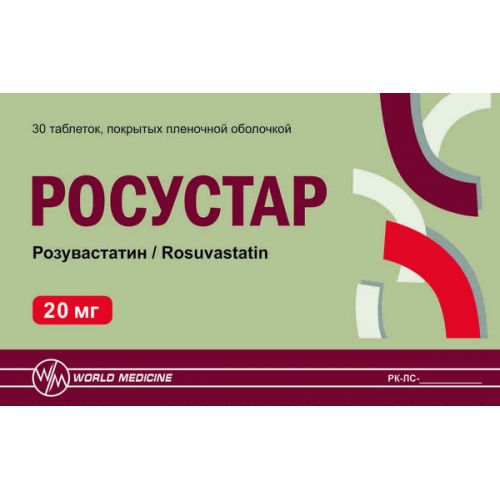
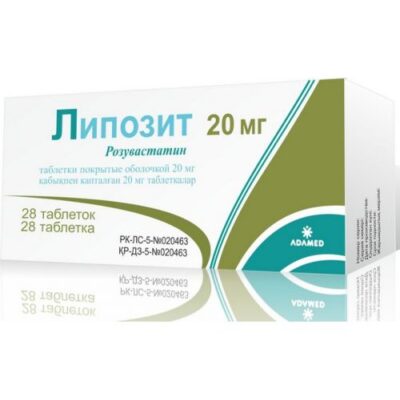
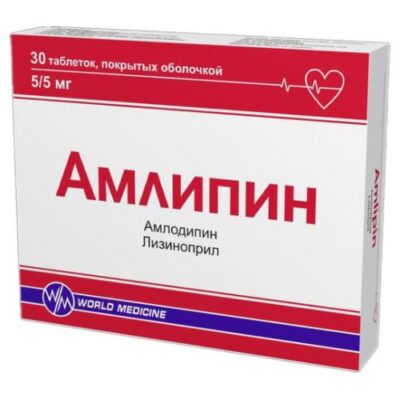
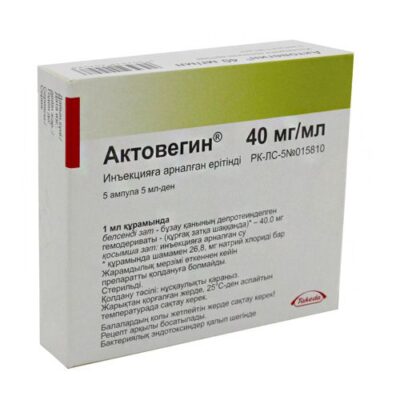
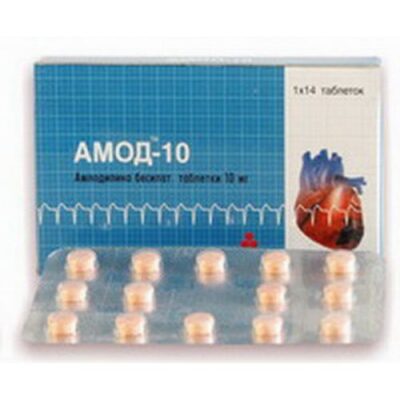
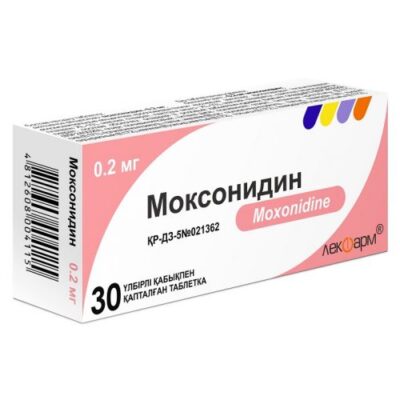
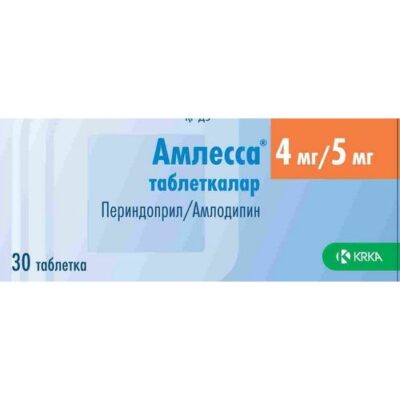
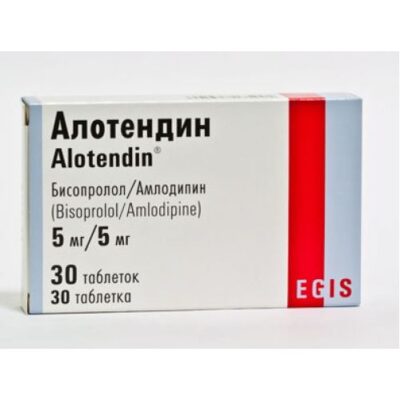

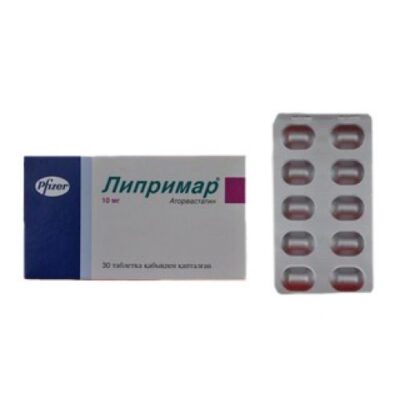
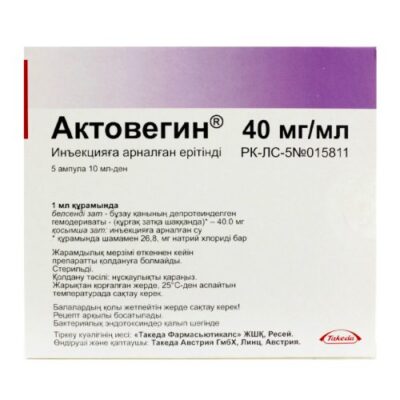






Reviews
There are no reviews yet.